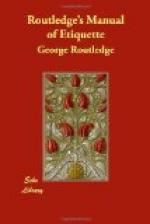We recommend as of primary importance, in order to be well and economically dressed, that people of slender means should have their dresses made at home, and should secure the services of a clever needle-woman who knows how to cut out and make, and has learned the mysteries of the art of dressmaking. With her assistance there is no reason why a home-made dress should not bear comparison with those of Madame Descon of London, or of Mr. Wirth of Paris. It is in the style, that first-class dressmakers excel. It is not in the actual needlework, which is often a very inferior affair. If, with the help of “Le Follet,” ladies will give some attention to the subject of dress, and will assist their maids with suggestions and approval, they will find themselves amply repaid, not only by their own personal appearance, but also by the small outlay of money.
* * * * *
V.—ACCESSORIES.
There are an infinite variety of things which are necessary in order to make a woman thoroughly well dressed, which do not come under the category of dresses. Some of these must be discussed, as they are of great importance.
To begin with bonnets. How much of a lady’s toilette depends upon her bonnet!—upon its make, its shape, its style, and the materials it is made of!
In these days, bonnets are much less ugly than they formerly were. They are not set at the back of the head as they used to be, when they made every woman look as if her neck had been broken. They offered no advantage. They did not screen the face from sun and wind, and no ladies could keep them on their heads without the help of long pins like skewers. The bonnet, as now worn, scarcely deserves the name of a bonnet. It is more like a cap than a bonnet; but, such as it is, it is exceedingly becoming to the young—more especially the style which has most recently come into fashion, in which, while it ties behind, below the chignon or large plait of hair, long ends of tulle, or lace, or blonde fall round the cheek, and fasten under the chin with a brooch or a flower. The effect of the lace against the face is very preferable to that of the fold of hard ribbon which was generally worn, and which was utterly devoid of all grace. Besides which, we have heard ladies praise the last fashion as being the most comfortable, because the absence of strings fastened under the chin enables them to eat, and sing, and talk without the necessity of taking off the bonnet, or of untying it. The extreme lightness of the modern bonnet is in itself a great recommendation. But if a bonnet is intended as a protection to the head from sun, wind, and rain, then, indeed, it must be allowed that the present fashion does not fulfil any of those intentions. A small saucer of tulle, or three-cornered bit of lace ornamented with a few flowers, which fits on the head in the small space that intervenes between the front hair and the beginning of the chignon, where it stops in order that the huge mass of hair now worn at the back of the head may be fully exhibited, does not do more than make a very pretty toilette. Useful and serviceable as a protection, it is not. But when it is contrasted with bonnets which were worn a few years ago, or with those which our mothers and grandmothers wore, we confess that we are glad of the change.




